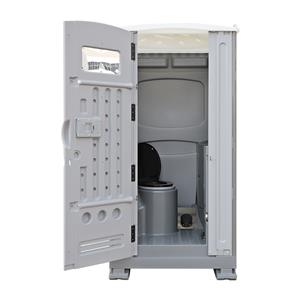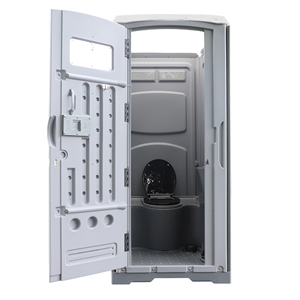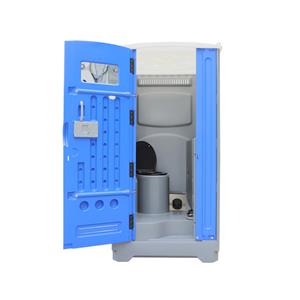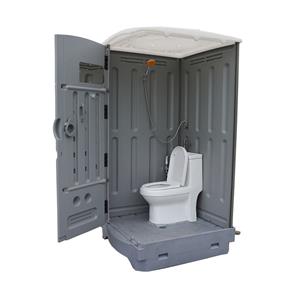How a Portable Shower Room Redefines Hygiene Solutions for Outdoor Spaces
When planning an outdoor event, remote job-site or temporary camp, you may often install portable toilets—but what about showers? That’s where a Portable Shower Room comes in. It delivers a full hygiene solution, letting users rinse, refresh and feel comfortable away from fixed infrastructure. In this blog, I’ll introduce the concept of a portable shower room (as a type of HDPE Mobile Bathroom or HDPE Plastic Bathroom), highlight its major advantages (especially the technical features), and answer common consumer-questions from your perspective. As a professional operator of such solutions, I’ll draw on technical knowledge and credible sources to show why this is a serious piece of equipment—not just a convenience extra.

What is a Portable Shower Room?
A Portable Shower Room refers to a self-contained mobile unit that integrates showering (and often hand-wash or hygiene facilities) into a transportable module. It’s designed for sites where fixed plumbing is unavailable, impractical or temporary—think festivals, construction camps, remote rural works, disaster relief, or large outdoor events. According to industry commentary: “When you’re building a successful rental business, understanding your equipment inside and out makes all the difference… Portable shower and toilet units represent a significant investment.”
In our context, the unit uses high-density polyethylene (HDPE) as a key construction material, which brings durability and lightweight transport. From the product news we learn: “Inside, you find non-slip floors to prevent slips, adjustable shower heads … and ventilation systems that whisk away steam.”
For clarity: when I use “Outdoor Movable Bathroom”, “HDPE Mobile Bathroom” and “Portable Shower Room” in this article, I refer to that same kind of unit—portable, rugged, hygienic and ready for outdoor/temporary installation.
Why it Matters: The Advantages of a Portable Shower Room
There are many reasons one should consider such a unit. On one side, it reflects a user-centric approach (better comfort, hygiene, dignity); on another side, it presents a strong technical and operational value (durability, flexibility, cost-effectiveness). Here I map out the key advantages, especially highlighting the technical attributes.
1. Superior Material & Construction Quality
The use of HDPE (High Density Polyethylene) shell brings high impact resistance, weather-proofing and longevity. As one site points out, HDPE units are “resist cracking, fading, and chemical damage while maintaining their structural integrity through countless transport cycles.”
In the product news, it mentions “non-slip floors … adjustable shower heads … ventilation systems” embedded in the design.
Because of the strong build, the units reduce maintenance needs. For example: “Low maintenance – portable shower rooms are able to offer a maintenance and cleaning option which frees you up to focus on your project.”
The materials chosen allow for extended outdoor use: resisting UV, rain, temperature extremes. For instance, the news states these units “can be installed anywhere that is lacking in permanent shower facilities”.
2. Operational Flexibility & Mobility
With portable installation, you can bring hygiene closer to users—reducing travel time, increasing comfort and boosting compliance. The article says: “Portable showers can make people feel clean no matter where they are.”
The ability to install the unit on any flat surface, then relocate as needed. The article mentions “they can also be moved from site to site quickly and effectively as required.”
Because it’s mobile, you avoid the fixed infrastructure cost and the long timeframe of building permanent shower facilities.
3. Enhanced User Experience & Hygiene
Non-slip flooring reduces accident risk, especially when wet. Ventilation systems improve air flow, reduce steam and odour buildup. These features are highlighted in the news: “Inside, you find non-slip floors … ventilation systems that whisk away steam.”
The flexibility to offer both hot and cold water options, ensure privacy, and provide a “home-from-home” experience in outdoor or remote settings.
Enhanced hygiene supports wellbeing: “The inclusion of portable showers improves individual cleanliness and contributes to overall cleanliness and hygiene at the event.”
4. Cost-Efficiency & Business Value
Because of the high durability and low maintenance, these units provide better return on investment. As an integrated sanitation solution is frequently more efficient than separate units. For example, in a rental context it says: “Transport one unit instead of two … Faster setup time … Simplified maintenance.”
For operators, fewer call-outs, less downtime and longer lifespan mean lower cost over time.
Technical Features in Depth
Let’s delve into the specific technical features that define a best-in-class Portable Shower Room, especially when constructed from HDPE and intended for outdoor mobile use. These features reinforce our expertise and show why this is a serious engineering solution.
Material & Shell Design
The outer shell is made from HDPE. This plastic offers excellent durability: weather resistant, UV stable, chemical resistant and impact tolerant. As a product page describes: “An HDPE portable toilet is a lightweight, durable, and easy-to-maintain outdoor sanitation solution … material … highly resistant to weather, chemicals and impact.”
Seamless or minimal-joint construction reduces weak points where water or damage could infiltrate.
Strong base / floor framework to support repeated use, transport, and heavy foot traffic.
Often features reinforced walls or double-skin options for insulation or acoustic control.
Floor, Drainage & Safety Features
Non-slip floors (textured HDPE or composite) ensure user safety even when wet. The article emphasises “non-slip floors to prevent slips.”
Proper drainage systems (floor drains, pump-out tanks) to remove water quickly and avoid standing water.
Interior surfaces sloped or designed for rapid flow of water, reducing contamination risks.
Integration of anti-microbial surface options or easy-clean coatings may further enhance hygiene.
Shower System & Water Management
High-quality pump and hose systems; earlier guidance notes: “You must ensure that the shower has a high-quality pump that does not clog easily. Also, ensure that the pump requires little maintenance.”
Adjustable shower heads allow user comfort; water temperature control may be included (hot & cold) to replicate comfort of fixed installations. As one source notes: “most of them produce both hot and cold water, so your guests will feel at ease.”
Freshwater tank(s) or external connection; wastewater or grey-water tank(s) with pump-out or drain connection.
Ventilation systems to remove steam and manage relative humidity inside the unit (important for user comfort and to prevent mildew). From the product news: “ventilation systems that whisk away steam.”
Mobility, Installation & Transport Features
Units are designed for forklift pockets, crane lift rings or transport vehicle compatibility to enable relocation.
Flat-surface or ramp entry options facilitate ease of use and comply with accessibility standards if required.
Quick-connect water, waste and power hookups reduce installation time and logistical costs.
Modular or stackable options might allow for configurability of layout depending on site constraints.
Maintenance, Hygiene & Long-Term Performance
The HDPE shell means less corrosion, less chemical damage, and less need for repainting or repair.
Smooth interior surfaces = easier cleaning, faster turnaround between uses.
Strong design = fewer repair calls, less downtime, higher uptime and better ROI.
According to the industry article: “The lifespan of well-constructed units often exceeds 15 years with proper maintenance.”
From a Consumer’s Perspective: Key Questions Answered
As a decision-maker—whether event planner, site manager or rental fleet owner—you’ll naturally ask questions. Here are several common questions and succinct answers.
Q: Will putting a Portable Shower Room on-site make a real difference?
A: Yes — it offers a comfortable, clean environment for users to rinse and refresh; improves morale, hygiene and site reputation.
Q: How durable is it—will it survive outdoor, harsh conditions?
A: Absolutely. With HDPE construction, non-slip flooring, weather-resistant shell and design built for transport, it’s built to last.
Q: How flexible is installation and relocation?
A: Very flexible. Many units are designed for quick setup, relocation, minimal civil works and adapt to flat surfaces or remote areas.
Q: How will maintenance and hygiene be managed?
A: Built-in features such as smooth surfaces, efficient drainage, ventilation, and pump-out tanks reduce labour and ensure high hygiene standards.
Q: Does this make financial sense compared to fixed installations or standard portable toilets?
A: Yes — while upfront cost may be higher, mobility, durability, reduced maintenance and added value to users typically deliver higher ROI.
Q: Can I provide a premium user experience (for events or high-end applications)?
A: Yes — features like hot/cold water, private changing areas, non-slip surfaces, ventilation and high-quality finish all help deliver premium experience.
Q: What should I check when selecting a unit?
A: Confirm material (HDPE), floor safety features, water/heating options, drainage capacity, transport features (forklift pockets, lift rings), and manufacturer reputation.
Real-World Applications: Where Portable Shower Rooms Shine
Seeing the product in action helps illustrate why these units matter—and how they serve different sectors.
Outdoor Events & Festivals
Large gatherings often lack fixed shower facilities. Providing an Outdoor Movable Bathroom meets attendee expectations for comfort and cleanliness—and can become a differentiator in event satisfaction.
Construction Sites & Work Camps
Workers finishing tough shifts benefit from onsite showers rather than travelling off-site. These units help morale, productivity and safety (especially where dirt, dust or PPE has been used). The article says: “When workers come into contact with potentially harmful materials … a portable shower room will give them the means to wash thoroughly.”
Remote or Temporary Installations
In disaster relief zones, remote camps, film-sets or remote worksites, fixed facilities may be impossible. A Portable Shower Room offers immediate installation, mobility and hygiene for serious applications.
Family-Friendly Venues & Tourism Sites
Parks, campsites, glamping sites or beachside venues benefit from units that feel modern and clean. Visitors appreciate well-designed facilities with hot water, private stalls, and that sense of comfort. The guidance: “Portable showers are a great alternative … ideal for festival-goers, construction workers and campers alike.”
How to Choose the Right Portable Shower Room
Selecting the right unit requires matching your site, usage, and budget. Here are key factors to evaluate:
Material & build: Prioritise HDPE shell, strong structural base, non-slip floor and quality drainage.
Water/heat systems: Does the unit offer hot and cold water? Is the pump appropriate for your usage rate?
Floor plan & user comfort: Are stall sizes adequate? Are changing areas or benches included? Are privacy and ventilation addressed?
Mobility features: Forklift slots, crane rings, easy hookup for utilities, ability to relocate.
Maintenance/hygiene features: Smooth surfaces, efficient drainage, ventilation to control humidity/odour.
Transport/installation logistics: Ensure metric dimensions fit your site, transport vehicles, permit requirements.
Manufacturer credibility: Look for proven track record, service support, clear specs and reusability.
Cost vs return: Consider usage frequency, seasons, rental value, maintenance cost and flexibility when comparing to fixed installation.
Conclusion
In today’s world where flexibility, comfort and inclusivity matter, a Portable Shower Room built as an HDPE Mobile Bathroom or HDPE Plastic Bathroom is far more than a “nice to have”. It’s a strategic investment in user experience, operational efficiency and long-term performance. From strong materials and smart engineering to flexible installation and hygiene features, the technical advantages align with human needs—whether you’re organizing a festival, running a construction site or managing a remote facility.
When you choose such a unit, you’re not simply installing “another unit” — you’re delivering dignity, convenience and quality. And in the process, you strengthen your brand reputation, satisfy your users and optimise your operational lifecycle.




